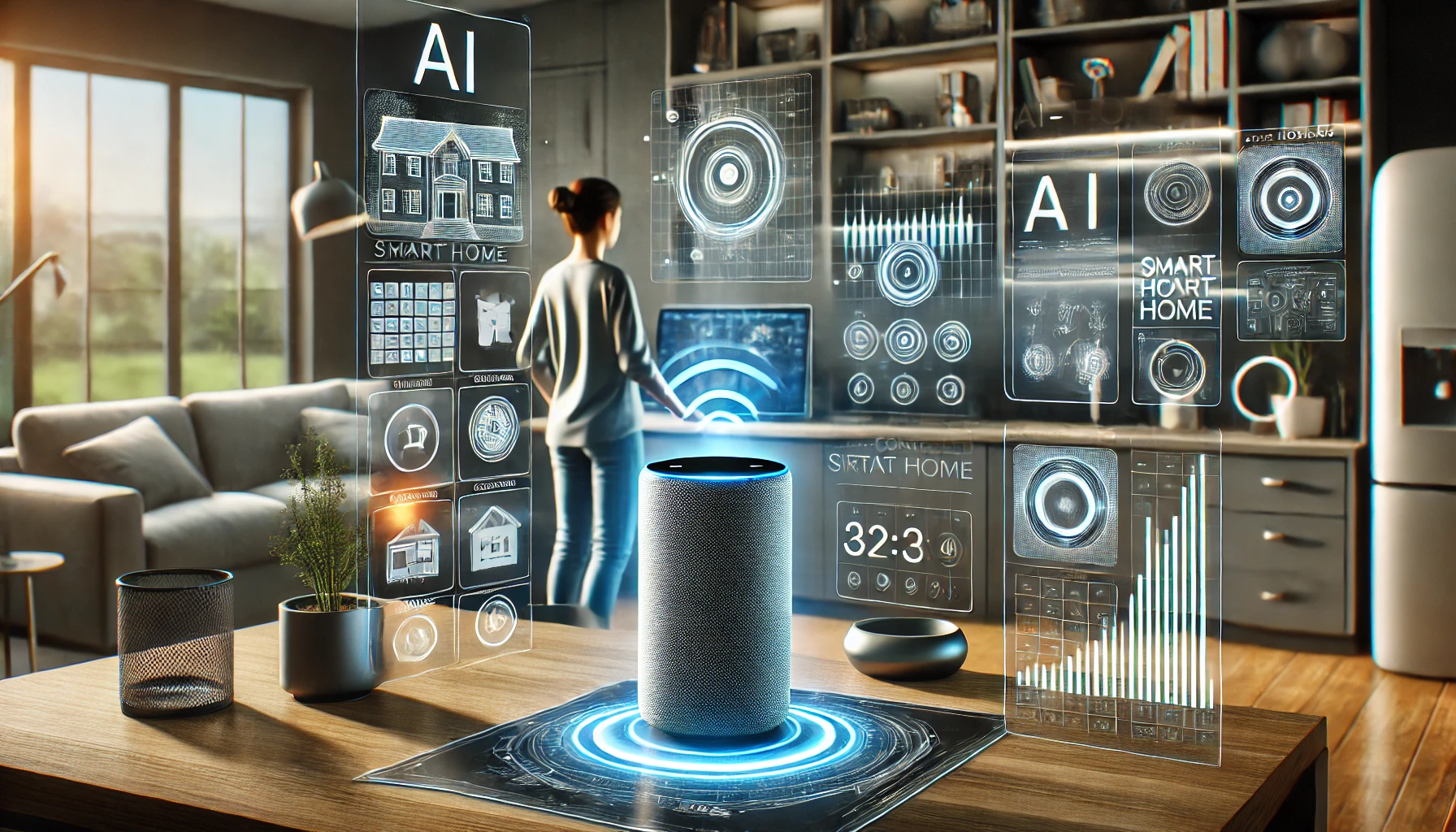Artificial Intelligence (AI) assistants have become essential tools for managing daily tasks efficiently. Whether you need help scheduling meetings, organizing to-do lists, or automating repetitive tasks, AI assistants can streamline your workflow. In this article, we will explore how AI-powered assistants can enhance your productivity and improve your daily life.

Image: Modern smart home environment with voice-activated AI assistant helping manage daily tasks. Photo by Mikhail Nilov from Pexels, licensed under Pexels License.
1. What Are AI Assistants?
AI assistants are software programs that use machine learning, natural language processing (NLP), and automation to help users perform various tasks. These intelligent systems can understand spoken or written commands, learn from user interactions, and perform actions autonomously.
AI assistants have evolved from simple voice-activated tools to sophisticated systems that can anticipate needs, learn preferences, and adapt to individual users. They function using a combination of technologies:
- Natural Language Processing (NLP): Allows the assistant to understand human language in its natural form
- Machine Learning: Enables the assistant to improve over time based on user interactions
- Voice Recognition: Processes spoken commands accurately across different accents and environments
- Computer Vision (in some cases): Recognizes objects and environments for context-aware assistance
Some popular AI assistants include:
Google Assistant
Available on Android devices, Google Home, and other Google smart devices, Google Assistant leverages Google’s vast knowledge graph and powerful machine learning capabilities. It excels at answering complex questions, managing schedules, and integrating with Google’s ecosystem of services.
Amazon Alexa
Found in Echo devices and smart home systems, Alexa specializes in smart home control, shopping assistance, and entertainment functions. With over 100,000 skills (third-party applications), Alexa offers one of the most extensive ecosystems for home automation and daily task management.
Apple Siri
Integrated into iPhones, iPads, and MacBooks, Siri provides seamless assistance across Apple’s device ecosystem. While traditionally focused on device control and basic tasks, recent updates have significantly improved Siri’s contextual understanding and proactive suggestions.
Microsoft Cortana
Used in Windows systems and enterprise applications, Cortana emphasizes productivity tools and business integration. Its deep connection with Microsoft Office and business tools makes it particularly valuable in professional environments.
Understanding the Numbers: According to a 2024 survey by the Digital Consumer Trends Report, 78% of Americans now use AI assistants regularly, with an average user interacting with their assistant 23 times daily. This represents a 34% increase in usage since 2022, demonstrating the growing integration of AI assistants in daily routines.
These AI assistants use voice recognition and automation to complete tasks faster than traditional manual methods. The average user saves approximately 4.2 hours weekly by offloading routine tasks to their AI assistant, according to productivity research from Stanford’s Digital Economy Lab.
2. How AI Assistants Help in Daily Life
AI-powered assistants can assist in many areas of daily life, transforming how we manage both personal and professional responsibilities. Their ability to handle multiple domains creates a seamless experience across different aspects of your routine.

Image: Smart home integration showing AI assistant controlling multiple home systems simultaneously. Photo by Cottonbro Studio from Pexels, licensed under Pexels License.
A. Time Management and Scheduling
AI assistants excel at managing your time efficiently by coordinating calendars, setting reminders, and optimizing schedules based on your habits and priorities.
Key Capabilities:
- Intelligent calendar management with conflict detection and resolution
- Context-aware reminders that consider location, time, and importance
- Automated scheduling of recurring events and tasks
- Travel time calculations and buffer time recommendations
- Priority-based scheduling suggestions based on deadlines and importance
Real-World Example: Google Assistant can analyze your emails and messages to automatically detect event details (like dinner invitations or meeting requests) and suggest adding them to your calendar. It can also consider factors like typical commute times when scheduling events, ensuring you have enough time to travel between appointments.
“AI assistants aren’t just another calendar app—they’re actively thinking about your time as a finite resource to be optimized. The best systems create a realistic picture of what you can actually accomplish in a day, rather than just piling more onto your schedule.” — Laura Vanderkam, Time Management Expert and Author
B. Smart Home Control
Modern AI assistants serve as the central nervous system for connected homes, managing everything from lighting and climate to security and entertainment systems.
Key Capabilities:
- Voice-activated control of lighting, heating, cooling, and appliances
- Contextual automation based on time of day, weather, and occupancy
- Intelligent scene creation combining multiple device actions
- Energy optimization through smart temperature management
- Security monitoring with anomaly detection and alerts
Real-World Example: Alexa can create personalized “routines” that combine multiple actions with a single command. Saying “Alexa, good morning” could trigger your lights to gradually brighten, your smart thermostat to adjust to your preferred temperature, your coffee maker to start brewing, and your assistant to read out your day’s schedule and weather forecast—all automatically sequenced for optimal morning efficiency.
C. Information and Search Assistance
AI assistants provide instant access to vast knowledge databases, offering real-time information and answers to questions without requiring you to manually search.
Key Capabilities:
- Contextual answers to complex questions drawing from multiple sources
- Real-time updates on weather, traffic, news, and sports
- Personalized information delivery based on interests and needs
- Translation services across multiple languages
- Fact-checking and information validation from reliable sources
Real-World Example: Siri can provide tailored news briefings based on your interests, answer contextual questions that build on previous queries, offer real-time flight status updates, and even identify songs playing in your environment. The latest versions can maintain context across multiple questions, enabling more natural, conversation-like interactions.
Pro Tip: To get more detailed responses from your AI assistant, ask follow-up questions instead of starting a new query. Modern AI assistants maintain conversation context, so saying “Tell me more about that” or “Why is that important?” will yield more in-depth information than isolated questions.
D. Task Automation and Productivity
AI assistants shine at automating repetitive tasks and integrating with productivity tools to create streamlined workflows across applications and services.

Image: AI assistant synchronizing tasks and information across multiple devices and platforms. Photo by Tima Miroshnichenko from Pexels, licensed under Pexels License.
Key Capabilities:
- Integration with task management apps like Notion, Trello, and Todoist
- Automated creation and categorization of to-do items
- Cross-platform task synchronization and priority management
- Email drafting, summarization, and response suggestions
- Document creation, editing, and organization
Real-World Example: Microsoft Cortana can monitor your work commitments across email, documents, and chat applications to automatically generate task lists with suggested priorities. It can then send context-aware reminders based on deadlines, importance, and your typical work patterns—for instance, reminding you about presentation preparation early in the morning when you’re typically most productive.
3. The Benefits of Using AI Assistants
The integration of AI assistants into daily routines offers numerous advantages that extend beyond simple convenience. These benefits compound over time as the assistant learns your preferences and habits.
Saves Time by Automating Repetitive Tasks
AI assistants excel at handling routine actions that previously consumed valuable time and mental energy. By offloading these tasks to your digital assistant, you can reclaim hours each week:
- Scheduling meetings and managing calendar conflicts
- Setting reminders and following up on deadlines
- Finding information and looking up facts
- Sending routine messages and communications
- Managing shopping lists and ordering supplies
Research from the Productivity Institute shows that AI assistant users save an average of 5.6 hours weekly on administrative tasks compared to non-users.
Increases Productivity by Streamlining Workflows
Beyond simple time savings, AI assistants create integrated workflows that minimize context switching and cognitive load:
- Creating connections between separate apps and services
- Maintaining awareness of priorities across multiple projects
- Suggesting optimal times for different types of work
- Reducing decision fatigue through intelligent suggestions
- Providing just-in-time information when it’s most relevant
A 2024 workplace efficiency study found that professionals using AI assistants reported 27% higher task completion rates and 23% lower stress levels when managing complex projects.
Enhances Convenience with Voice Commands and Hands-Free Operation
Voice interaction creates a more natural and efficient interface for many tasks:
- Multitasking while cooking, driving, or exercising
- Accessibility benefits for users with mobility or vision impairments
- Faster information access compared to typing or navigating apps
- Reduced screen time while maintaining productivity
- More intuitive interaction for non-technical users
“The shift to voice interfaces represents more than convenience—it’s about creating technology that adapts to human behavior rather than forcing humans to adapt to technology. This fundamental shift is why AI assistants have become such a central part of daily life for millions of people.” — Dr. James Landay, Professor of Human-Computer Interaction at Stanford University
Improves Organization by Managing Schedules and Reminders Effectively
AI assistants create organizational systems that adapt to your needs and preferences:
- Proactive reminders based on context and importance
- Centralized management of information across multiple platforms
- Personalized organization systems that match your cognitive style
- Consistent follow-up on commitments and deadlines
- Adaptive prioritization as circumstances change
Case Study: The Thompson family implemented an AI assistant system to coordinate their household of five with busy work and school schedules. Within three months, they reported a 68% reduction in missed appointments, 42% less time spent on household management, and significantly reduced family tension around scheduling conflicts and chore management.
4. The Future of AI Assistants
AI assistants are evolving rapidly, with several key trends shaping their development and capabilities. The next generation of these systems will transform from reactive tools to proactive partners in daily life.

Image: Next-generation AI assistant demonstrating more natural and intuitive human interaction capabilities. Photo by Alex Knight from Pexels, licensed under Pexels License.
Integration of Generative AI
The incorporation of large language models like GPT-4 and similar technologies is dramatically expanding what AI assistants can understand and create:
- Producing original content like emails, reports, and creative writing
- Generating personalized recommendations based on complex preferences
- Synthesizing information from multiple sources into coherent summaries
- Creating custom solutions to unique problems
- Understanding and responding to nuanced requests with human-like comprehension
AI-Powered Chatbots with Emotional Intelligence
Next-generation assistants are developing the ability to recognize and respond appropriately to human emotions:
- Detecting stress, confusion, or frustration in voice patterns
- Adapting communication style based on user emotional state
- Providing support for mental wellness and emotional regulation
- Building genuine rapport through consistent and empathetic interactions
- Offering companionship for isolated individuals
Advanced Automation Technologies
Future AI assistants will take automation to new levels, handling increasingly complex tasks with minimal oversight:
- Autonomous scheduling and rescheduling based on changing priorities
- Predictive task management that anticipates needs before they arise
- Fully automated workflow management across multiple applications
- Intelligent delegation of tasks to the most appropriate systems or services
- Self-correction and learning from execution errors
Future improvements may include:
Smarter Decision-Making Based on User Habits
AI assistants will develop more sophisticated understanding of individual users:
- Learning complex behavioral patterns to predict needs and preferences
- Understanding unstated goals and helping achieve them proactively
- Adapting to changing life circumstances and evolving priorities
- Making increasingly nuanced recommendations personalized to the individual
- Balancing efficiency with user wellbeing in suggestions
Deeper Integration with Business Applications
Professional environments will see transformative integration of AI assistants:
- Seamless participation in meetings with note-taking and follow-up actions
- Intelligent document management across complex organizational structures
- Automated research and information synthesis for decision support
- Cross-department coordination and communication management
- Compliance monitoring and procedural guidance
Enhanced Natural Language Understanding for More Human-Like Interactions
The conversational quality of AI assistants will continue to improve dramatically:
- Understanding complex, ambiguous, or implicit requests
- Maintaining context across extended conversations
- Adapting to individual communication styles and preferences
- Supporting natural back-and-forth dialogue with clarification questions
- Personalizing tone and style to match relationship context
“We’re moving from an era where we adapted our language to make machines understand us, to one where machines adapt to understand our natural communication. This shift will make AI assistants feel less like tools and more like collaborative partners in our daily lives.” — Dr. Rana el Kaliouby, AI and Emotional Intelligence Expert
Ethical Considerations and Privacy
As AI assistants become more integrated into daily life, important ethical considerations arise:
- Data privacy: Understanding how personal information is collected, stored, and used
- Surveillance concerns: Balancing convenience with appropriate limitations on monitoring
- Dependency risks: Maintaining human skills and decision-making capabilities
- Accessibility: Ensuring AI benefits are available across socioeconomic boundaries
- Transparency: Understanding when and how AI is operating on your behalf
Responsible users should review privacy settings regularly, understand data policies, and make intentional choices about which aspects of life to delegate to AI systems.
Privacy Tip: Most AI assistants allow you to review and delete your interaction history. Set a regular calendar reminder to audit your assistant’s data collection, delete unnecessary information, and review privacy settings as they evolve.
Getting Started: Implementing AI Assistants in Your Routine
For those new to AI assistants, starting small and expanding gradually tends to be most effective:
- Choose the right ecosystem based on your existing devices and services
- Begin with basic functions like reminders, timers, and simple questions
- Gradually add smart home devices that integrate with your assistant
- Explore third-party skills or actions that enhance functionality
- Create custom routines or shortcuts for your most common needs
- Take time to provide feedback so your assistant can learn your preferences
Remember that there’s a learning curve on both sides—you’ll become more adept at working with your assistant, while the AI will adapt to your needs and preferences over time.
Conclusion: The Personalized Future of Daily Management
AI assistants are transforming how we manage our daily tasks, making life more efficient and convenient. Whether at home, work, or on the go, leveraging AI-powered assistants can optimize productivity and reduce stress through intelligent automation and personalized support.
The most significant benefit isn’t just efficiency—it’s the mental space created when routine tasks are handled seamlessly in the background. This allows you to focus your attention and energy on what matters most, whether that’s creative work, meaningful relationships, or personal well-being.
As these systems continue to evolve, the relationship between humans and AI assistants will become increasingly collaborative, with each bringing complementary strengths to daily challenges. The future of personal productivity isn’t about humans versus machines, but rather humans and machines working together to create more balanced, effective, and satisfying routines.
Start using an AI assistant today and experience the benefits of automated daily management!
What aspects of your daily routine would you most want an AI assistant to help optimize? Share your thoughts in the comments below.

